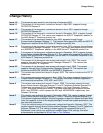
Terms Used in This Guide
Issue 6 February 2007 11
Terms Used in This Guide
802.1Q
802.1D
802.1Q defines a layer 2 frame structure that supports VLAN identification and a QoS
mechanism usually referred to as 802.1D.
802.1X Authentication method for a protocol requiring a networking device to authenticate
with a back end Authentication Server before gaining network access. Applicable
4600 Series IP telephones support IEEE 802.1X as a Supplicant with the EAP-MD5
authentication method.
ARP Address Resolution Protocol, used to verify that the IP Address provided by the
DHCP server is not in use by another IP telephone.
CLAN Control LAN, type of TN799 circuit pack.
DHCP Dynamic Host Configuration Protocol, an IETF protocol used to automate IP Address
allocation and management.
DiffServ Differentiated Services, an IP-based QoS mechanism.
IETF Internet Engineering Task Force, the organization that produces standards for
communications on the internet.
LAN Local Area Network.
LLDP Link Layer Discovery Protocol. All IP Telephones with an Ethernet interface support
the transmission and reception of LLDP frames on the Ethernet line interface in
accordance with IEEE standard 802.1AB.
MAC Media Access Control, ID of an endpoint
PAE Port Access Entity. The protocol entity associated with a port. The PAE supports the
protocol functionality associated with the authenticator, supplicant, or both.
QoS Quality of Service, used to refer to several mechanisms intended to improve audio
quality over packet-based networks.
RRQ Read Request packet. A message sent from the 4600 Series IP Telephone to the
TFTP server, requesting to download the upgrade script and the application file.
SES SIP Enablement Services. Supports the deployment of duplicated servers with
synchronized databases.
SIP Session Initiation Protocol. An IETF standard protocol for IP communication. SIP
enables IP telephony gateways, client endpoints, PBXs, and other communication
systems or devices to communicate with each other. SIP mainly addresses the call
setup and tear down mechanisms of sessions and is independent of the transmission
of media streams between caller and callee. SIP is an alternative to H.323 for VoIP
signaling.
Supplicant An entity at one end of a point-to-point LAN segment that is being authenticated by
an authenticator at the other end of that link.
TCP/IP Transmission Control Protocol/Internet Protocol, a network-layer protocol used on
LANs and internets.
Time-to-
Service
(TTS)
A new feature with Communication Manager 4.0, IP Endpoint Time-to-Service (TTS)
decouples gatekeeper H.323 registration from TCP socket establishment for call
signaling, thus reducing the time for the endpoint to come into service.
TFTP Trivial File Transfer Protocol, used to provide downloading of upgrade scripts and
application files to the IP telephones.
UDP User Datagram Protocol, a connectionless transport-layer protocol.
Unnamed
Registration
Registration with Avaya Communication Manager by an IP telephone with no
extension. Unnamed registration is typically used to limit outgoing calling.
VLAN Virtual LAN.


















